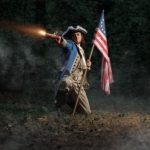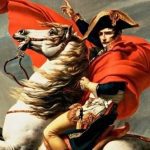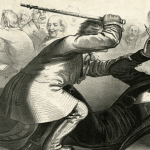 Mysteries
Mysteries  Mysteries
Mysteries  History
History 10 Surprising Stories About the Texas Rangers
 Humans
Humans 10 Philosophers Who Were Driven Mad by Their Own Theories
 Miscellaneous
Miscellaneous 10 Video-Game-Worthy Weapons and Armors from History
 Weird Stuff
Weird Stuff 10 Psychics Who Accurately Predicted Wartime Events
 The Arts
The Arts 10 Pieces of Art Inspired by a Broken Heart
 Health
Health 10 Science Fiction-Sounding New Medical Treatments
 History
History 10 Surprising Facts About the Father of Submarine Warfare
 Space
Space Ten Astonishing New Insights into Alien Worlds
 Weird Stuff
Weird Stuff 10 Bizarre Summer Solstice Rituals Still Practiced Today
 Mysteries
Mysteries Top 10 Haunting Facts About the Ghost Ship MV Alta
 History
History 10 Surprising Stories About the Texas Rangers
 Humans
Humans 10 Philosophers Who Were Driven Mad by Their Own Theories
Who's Behind Listverse?

Jamie Frater
Head Editor
Jamie founded Listverse due to an insatiable desire to share fascinating, obscure, and bizarre facts. He has been a guest speaker on numerous national radio and television stations and is a five time published author.
More About Us Miscellaneous
Miscellaneous 10 Video-Game-Worthy Weapons and Armors from History
 Weird Stuff
Weird Stuff 10 Psychics Who Accurately Predicted Wartime Events
 The Arts
The Arts 10 Pieces of Art Inspired by a Broken Heart
 Health
Health 10 Science Fiction-Sounding New Medical Treatments
 History
History 10 Surprising Facts About the Father of Submarine Warfare
 Space
Space Ten Astonishing New Insights into Alien Worlds
 Weird Stuff
Weird Stuff 10 Bizarre Summer Solstice Rituals Still Practiced Today
Ten Totally Forgotten Stars of the American Revolution
The American Revolution has many well-known heroes. Even today, some are still nearly legendary, like Molly Pitcher, Paul Revere, and Nathan Hale. However, many unsung individuals made invaluable contributions to American independence too. Sadly, these heroes have been largely forgotten by history. While names like Lafayette still resonate, countless others have been consigned to near obscurity. They are unjustly overlooked. And they deserve acknowledgment. So today, we’ll give them their due!
The Revolution’s victory would have been unlikely without the selfless actions of many people, including the ten on this list. They willingly risked their lives and fortunes in the pursuit of American liberty from the British Empire. Unfortunately, the majority of Americans remain unaware of their efforts and sacrifices. Therefore, it is crucial to honor these ten forgotten heroes of the American Revolution now. They truly deserve the recognition and gratitude of future generations. They fought for freedom and assisted the cause unerringly. Without these ten souls, the United States might have looked very, very different today—or not existed at all.
Related: Top 10 Incredible People Who Were Heroes Of The Holocaust – 2020
10 Seth Warner
In the late Colonial era, Vermont was called the Hampshire Grants. It was claimed by both New York and New Hampshire. The residents preferred independence from both colonies, though. So they formed the Green Mountain Boys. Those independence-minded men were led by Ethan Allen and Seth Warner. These towering figures, both locally renowned, opposed the authorities—especially those from New York.
Ethan Allen gained national fame by capturing Fort Ticonderoga from the British in 1775. Meanwhile, Seth Warner was less recognized, but he still played a crucial role in the American Revolution. After participating in the Canadian invasion, Warner fought alongside John Stark and Benedict Arnold in the Saratoga Campaign. There, he significantly contributed to the Patriot victory at Bennington. Despite being outlawed in New York for his earlier actions with the Green Mountain Boys, Warner remained devoted to the patriotic cause for the nation as a whole.
Following the war, Allen’s political career overshadowed Warner’s influence in Vermont. Warner’s health deteriorated due to his numerous military campaigns, and he tragically passed away at the age of only 41 in 1784. Since then, Ethan Allen’s contributions to the American Revolution have overshadowed Warner’s, making him relatively unknown outside Vermont. Still, Vermont wouldn’t have been so formidable during the Revolution without Seth Warner. And the northeastern colonies may not have succeeded in ousting the Redcoats were it not for his ferocity.[1]
9 Thomas Sumter
In the 2000 movie The Patriot, Mel Gibson plays Benjamin Martin. He was a planter and guerrilla fighter inspired by the legendary Francis Marion—also known as the Swamp Fox. But Marion wasn’t the only South Carolina guerrilla from the Revolutionary War. Another lesser-known and equally fierce fighter from the Palmetto State was Thomas Sumter. In his own way, Sumter served as the model for much of Martin’s character. Just like Martin, Sumter’s plantation in the High Santee region was burned by the British. He led irregular forces in a campaign against the British after that. And in turn, he nearly had his entire command wiped out.
Sumter got his nickname “Carolina Gamecock” after a confrontation with British Colonel Banastre Tarleton’s troops at the Battle of Blackstock’s Farm. Tarleton reported to Lord Cornwallis that Sumter fought with the ferocity of a gamecock. Although the battle itself was small, it was part of a series of American actions to disrupt British communication and supply lines in the Carolinas. Soon enough, Sumter’s relentless harassment of Cornwallis earned him the title of the British commander’s “greatest plague” in the Deep South.
After the war, Sumter ventured into politics. He served in the U.S. House of Representatives and the Senate until he resigned in 1810. Despite his considerable fame during his lifetime, Sumter’s personality often alienated even his friends. Eventually, it led to his declining reputation shortly following his death. He outlived all other generals from the American Revolution, though, finally passing away in 1832. After his death, Fort Sumter—the site where the American Civil War later began—was named in his honor.[2]
8 John Stark
John Stark was a member of Rogers’ Rangers during the French and Indian War. During it, he didn’t care for the “gentlemen” officers in the British Army. After the war, he became a farmer in New Hampshire. When news of the fighting in Lexington and Concord reached him on April 23, 1775, he rejoined the militia as a colonel. By early June, Stark and his regiment were part of the Continental Army surrounding Boston.
Stark’s group played a crucial role in the Battle of Bunker Hill. There, they served as the rear guard during a key American walk back. He also took part in the siege of Boston, the ill-fated invasion of Canada, and the Battles of Trenton and Princeton. After Princeton, he returned to New Hampshire to recruit more troops for Washington’s army. However, political issues over promotion led him to resign. But his service was not over yet.
When British General John Burgoyne and his Indian allies advanced from Canada into upstate New York, Stark returned to duty. He commanded troops from New Hampshire and other Continental soldiers during the Saratoga Campaign. One of his notable achievements was leading the American forces to victory in the Battle of Bennington. They bested Burgoyne’s Hessian troops in a major win.
That victory forced the British to halt their advance through Vermont. In turn, Stark continued to serve with the American Northern Army for the rest of the war. Afterward, he returned to his farm in New Hampshire and faded into relative obscurity—although his contributions are remembered today.[3]
7 Henry Dearborn
Henry Dearborn was a captain in the Revolutionary War and a famed fighter of great repute. He led a New Hampshire militia in John Stark’s regiment. There, he fought bravely at Bunker Hill. He even joined Benedict Arnold’s invasion of Canada through the Maine wilderness. Dearborn’s detailed journals shed light on the arduous military march undertaken during this campaign.
However, his journey took a turn when he was captured by the British during the assault on Quebec on New Year’s Eve in 1775. After his release in May of the following year, Dearborn rejoined the Continental Army. There, he participated in the Saratoga campaign and endured the hardships of Valley Forge.
Dearborn’s notable contributions continued from there. He made appearances at major military skirmishes like Monmouth Courthouse. He also fought in John Sullivan’s notorious expedition against the Iroquois. And he played a crucial role in the Yorktown Campaign. In turn, he was present for the surrender of British armies at both Saratoga and Yorktown.
In the end, his gallantry earned him enduring recognition. Fort Dearborn in Detroit, Dearborn County in Indiana, and Fort Dearborn in Illinois are all named in his honor. Although his later military endeavors during the War of 1812 were less distinguished, Dearborn remained honorable.
However, as time passed, his achievements in the American Revolution gradually faded from history books. By the mid-19th century, he was largely forgotten. All this despite his subsequent government service, where he was even appointed as Minister to Portugal in the 1820s.[4]
6 Lord Stirling
William Alexander, better known as Lord Stirling, was the son of a successful lawyer and businessman from New York. He embraced his Scottish heritage and claimed the title of the Earldom of Stirling. Although his father did not pursue the title, William’s claim was recognized by Scottish courts. Soon enough, it was embraced by Americans, despite being ignored by the British House of Lords. However, his extravagant lifestyle, driven by his desire to live as a peer, plunged him into debt. When the Revolutionary War erupted, he went further into debt by forming and equipping his own regiment, the First New Jersey Regiment.
During the Battle of Long Island, despite the American defeat, Lord Stirling’s regiment valiantly held its ground against the British regulars. It resulted in heavy casualties, but they stood against their foes. Sadly, Lord Stirling was captured when his men were overwhelmed. But he wouldn’t be held down very long.
After his exchange, he rose to the rank of Major General. Soon, he played significant roles in crucial battles such as Trenton, Brandywine, Germantown, and Monmouth. Washington esteemed him highly, even entrusting him with command over the troops left behind in New York while the main army moved to Virginia and Yorktown in 1781.
Tragically, Lord Stirling passed away in Albany in January 1783, before the Revolutionary War’s conclusion. Despite his remarkable performance as one of Washington’s capable commanders, he remains largely unknown outside of New Jersey. In that state, his descendants have maintained his baronial estate. His claim to the Scottish Earldom of Stirling perished with him, and the title returned to obscurity as well.[5]
5 John Barry
John Barry was a shipmaster from Philadelphia who was called on to play a vital role in the American Revolution. Although overshadowed by the more famous John Paul Jones, Barry’s services were significant enough for the U.S. Navy to acknowledge him as one of the founding figures. Along with John Adams, Barry has been dubbed the “Father of the United States Navy.” At just 21 years old, the Irish-born Barry pledged his allegiance to the Continental Congress. He quickly became a captain in their service, commanding the brig the Lexington.
Throughout the war, Barry led various ships of the Continental Navy into battle. He also ventured out as a privateer between assignments. He captured numerous enemy vessels, quelled multiple mutinies, and mentored young officers who later achieved great success in the military. On March 10, 1783, he commanded the USS Alliance in the final battle of the American Revolutionary War.
With it, he impressively repelled two British ships that had more armaments. The Captain of one of the British ships in the fight—HMS Sybil—quickly acknowledged Barry’s exceptional leadership. The impressed Brit later publicly stated that he had never witnessed a ship fought as skillfully as the Alliance.
Following the war, Barry received the first-ever commission from the newly authorized United States Navy, known as Commission 1. It was even personally signed by President George Washington. The Navy acknowledges him now as its inaugural commissioned officer and first Flag Officer. Today and forever after, he holds the esteemed rank of Commodore. And yet, despite his remarkable achievements, Barry remains largely forgotten by the masses while John Paul Jones and others live on.[6]
4 Daniel Bissell
In the late summer of 1781, George Washington’s Continental Army camped near occupied New York City. At the time, the city was held by the main British army in North America. Washington was desperate for information on British plans and espionage before the battle. So he recruited Daniel Bissell, a soldier from Connecticut, to pose as a deserter and infiltrate the British lines. Bissell faced grave danger if his disguise was discovered, but it was the only play Washington had at the time.
Bissell journeyed to New York, joined Benedict Arnold’s regiment in the British army, and carefully observed their activities. While there, he committed everything to memory. In September 1782, a year after the British surrender at Yorktown, Bissell courageously deserted the British army. Then, he returned to the American encampments around New York. He shared valuable intelligence with Washington about British defenses. He also revealed that they had no intention of leaving their positions.
For his dual roles as a soldier and spy, Bissell received the Badge of Military Merit. That was the sole award authorized for troops during the American Revolution. Years later, it became the esteemed Purple Heart. Personally designed by George Washington, this military decoration is the second oldest in existence. Today, Bissell’s tombstone is even inscribed with news of his notable service. It bears the testament: “He had the confidence of Washington and served under him.” Surely, this man should not be lost to the sands of time![7]
3 Abraham Whipple
Abraham Whipple was an extraordinary seafarer from colonial Rhode Island. Despite his limited education, he taught himself advanced math and navigation skills. Known for his honesty and expertise, he amassed monetary success and renown as a commercial seaman. Then, he became a valued privateer. Soon enough, he was serving in the French and Indian War. Whipple’s defiance against the British began with the capture of revenue cutter the Gaspee in that skirmish. It proved to be a pivotal moment in American history.
When the Revolutionary War began in 1775, Whipple commandeered two ships with the help of fiery rebels up in Rhode Island. He played a crucial role in transporting much-needed gunpowder from Bermuda to Philadelphia. Soon, the Continental Congress seized his ships and enlisted them in the newly formed Continental Navy. With it, they appointed Whipple as the Navy’s first captain.
Over the next five years, he commanded various vessels for the military outfit. Through it all, he proved himself by capturing or destroying more British ships than any other Continental Navy officer. He even surpassed the total of the renowned John Paul Jones. Unfortunately, Whipple was captured on land by the British when Charleston fell in 1780. His navy days wrapped there—but he was brutal on the British before it ended.
After the war, Whipple turned to farming. He even became a founding member of the city of Marietta, Ohio. And yet, despite his significant contributions to the patriotic cause, he remains largely forgotten outside of Rhode Island and the Marietta region.[8]
2 Pierre-Augustin Caron de Beaumarchais
Pierre-Augustin Caron de Beaumarchais was a French playwright and philosopher. Today, he is best known for his works like The Marriage of Figaro, The Barber of Seville, and The Guilty Mother. All of them featured the now-infamous character Figaro. But his life went far beyond just that.
The son of a watchmaker, Beaumarchais invented a groundbreaking mechanism that greatly improved the accuracy of clocks and watches. When another watchmaker tried to steal his invention, Beaumarchais fiercely defended his creation. He gained public recognition through that fight and became a favorite at the French court.
During the American Revolution, Beaumarchais had significant business interests in Spain and France. Leveraging his connections, he established a fictional company called Hortalez et Cie. It secretly provided arms, clothing, and funds to support the rebellious Americans. Simultaneously, Beaumarchais used his influence within the French court to advocate for overt assistance to the Americans. After all, they were in a struggle against the British—France’s age-old adversary—and Beaumarchais wanted to see his enemies lose.
Beaumarchais and his business partners invested their personal fortunes in aiding the American cause even before France officially entered the Revolutionary War. They sank so much money into the fight that it nearly bankrupted them. And it was not until 1837, long after his passing, that Beaumarchais’s heirs received partial repayment for the funds they had contributed. Still, without his tireless efforts, the Continental Congress would have struggled to supply George Washington’s army during the most critical initial years of the conflict. Regrettably, history often overlooks his significant contributions to the United States. They are instead overshadowed by his enduring legacy as the creator of Figaro.[9]
1 Haym Salomon
In 1740, a Jewish man named Haym Salomon was born in Poland. He gained knowledge of European finance and learned languages, including German and French. Later, he moved to England. Then, in 1775, he moved to New York. In the Big Apple, he became a financial broker. When it came time to fight the British, Salomon sided with the Sons of Liberty during the Revolutionary War. However, his contributions were far more subtle than via direct combat.
As part of George Washington’s spy rings, Salomon engaged in espionage activities against the Redcoats. Eventually, those actions led to his capture by the British in New York. Despite their attempts, the British couldn’t convict him, though. Instead, he was held captive and made to serve as an interpreter for Hessian mercenaries.
Seizing the opportunity, Salomon encouraged the German troops to desert. However, he was caught again, convicted, and faced a death sentence. Escaping to Philadelphia, he established himself as a broker and helped raise funds for the Continental Army. Remarkably, Salomon’s efforts generated the modern-day equivalent of $16 million. That cash seriously aided the Revolutionary cause at the time it needed funding the most.
Salomon was pivotal in the final campaign leading to the British surrender at Yorktown. Throughout the war, he personally purchased hundreds of thousands of dollars worth of equipment and supplies. Sadly, the post-war debt left him practically penniless. He had bankrupted himself in saving the new nation. Tragically, Salomon passed away in 1785 at the age of just 44 in Philadelphia. Still, even today, he leaves behind a legacy of selfless service to the Revolutionary effort.[10]








